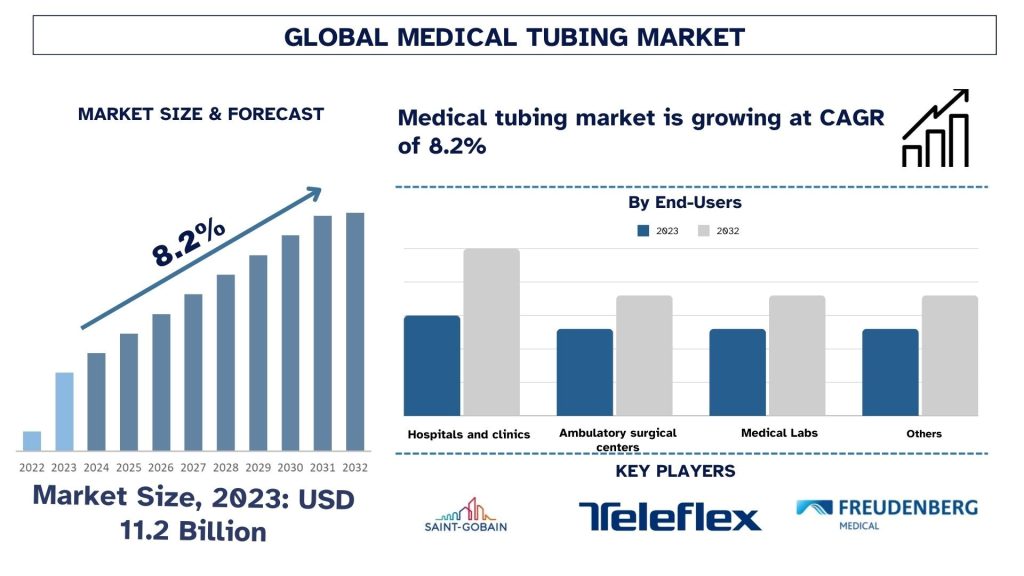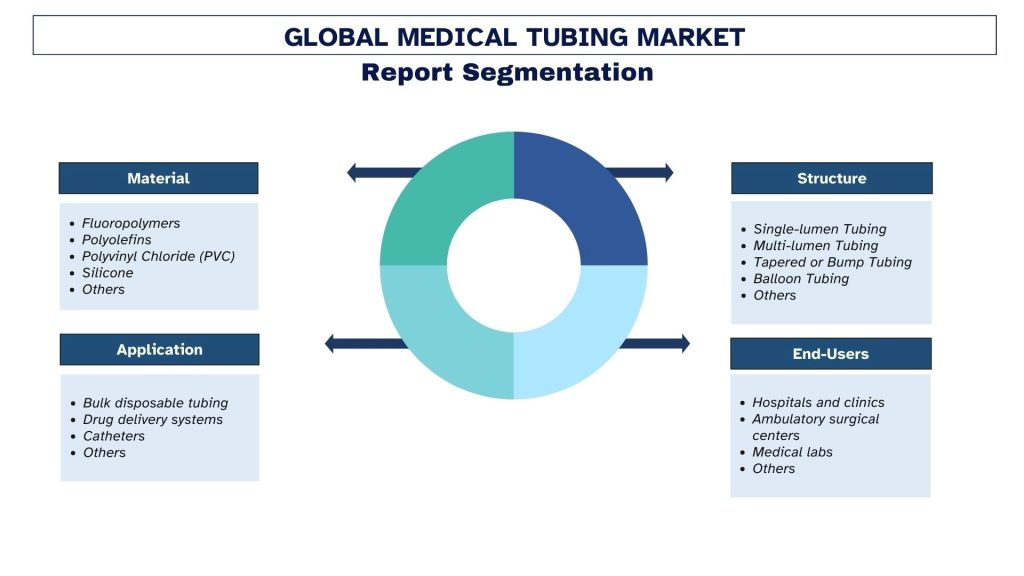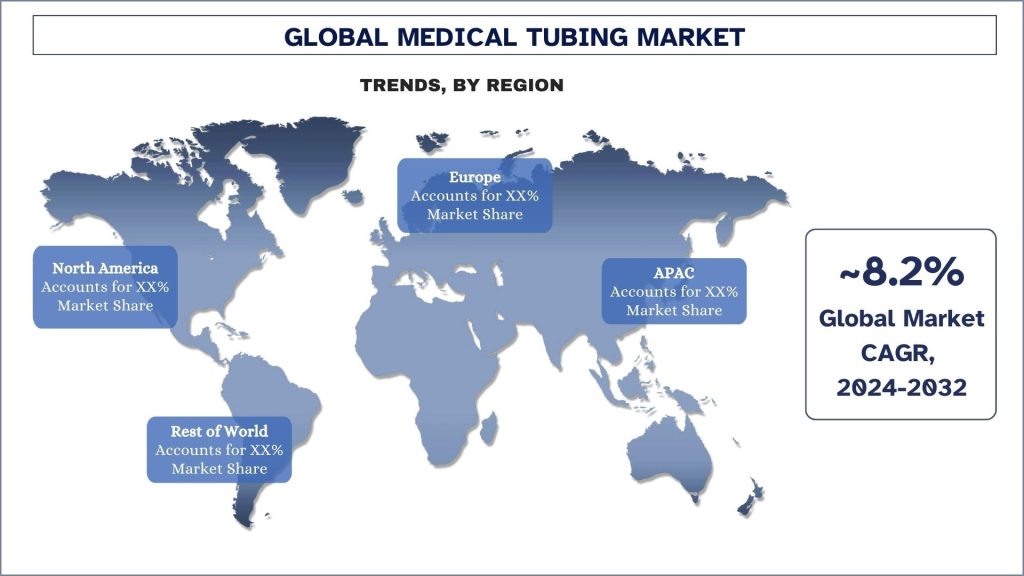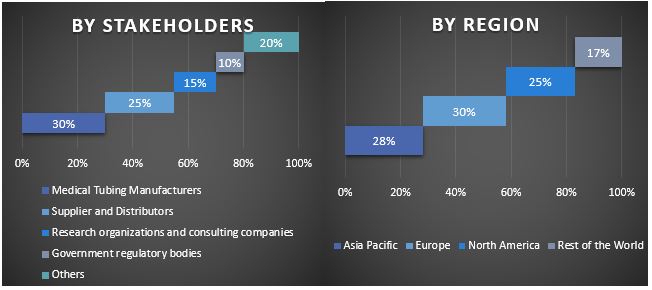Medical Tubing Market: Current Analysis and Forecast (2024-2024)
$3999 – $6999
Emphasis by Material (Fluoropolymers, Polyolefins, Polyvinyl Chloride (PVC), Silicone, and Others); Structure (Single-lumen Tubing, Multi-lumen Tubing, Tapered or Bump Tubing, Balloon Tubing, and Others); Application (Bulk disposable tubing, Drug delivery systems, Catheters, and Others); End-User (Hospitals and clinics, Ambulatory surgical centers, Medical labs, and Others); and Region and Country
| Pages: | 297 |
|---|---|
| Table: | 93 |
| Figure: | 162 |
| Report ID: | UMCH21972 |
| Geography: |

Report Description
Medical Tubing Market Size & Forecast
The Medical Tubing Market was valued at approximately USD 11.2 Billion in 2023 and is expected to grow at a robust CAGR of around 8.2% during the forecast period (2024-2032). Key trends that contribute to the development of the medical tubing market include the increase in demand for minimally invasive methods of treatment correspondent enhancement in the rate of diseases that require the utilization of highly developed medical elements.
Medical Tubing Market Analysis
Medical tubing has many applications in the healthcare industry such as fluid management and drainage, along with anesthesiology and respiratory equipment, intravenous (IVs), catheters, peristaltic pumps, and biopharmaceutical laboratory equipment. Moreover, medical tubing ensures cost efficiency and less time consumption for various medical operations. The rising demand for medical devices that have medical tubing as a part of the equipment is pushing its demand. Further, the increasing old age population is expected to drive the market demand in the forecast period as several health issues owing to reduced immunity strength require various treatments that include the implementation of medical tubing. Additionally, the growth of the healthcare industry in both developed and developing regions is raising the demand for medical tubing for surgical implants due to their properties such as lubricity and biocompatibility. Moreover, increasing demand for technically advanced medical devices to meet various neurological and surgical applications is elevating the medical tubing demand. The demand for minimally invasive medical procedures, advancements in medical tubing, and government initiatives to provide better healthcare facilities are also driving the market growth.
Medical Tubing Market Trends
This section discusses the key market trends influencing the fungicide segments as identified by our research experts.
Silicone Segment Transforming Industry
Silicone has a prominent share in the market. Silicone has numerous advantages over other materials, such as natural rubber. It is more bio-compatible than rubber medical tubes and does not support bacterial growth. Furthermore, silicone is recyclable and can be reused multiple times. Additionally, it has excellent dimensional stability and is resistant to various factors such as chemicals, temperature, and UV radiation.
North America holds a significant share of the market.
North America held a considerable share in the market and demand is expected to maintain a strong position during the foreseeable future. This can be attributed to the high expenditure in the healthcare industry and the growing old-age population in the region. For instance, according to the U.S. Census Bureau, more than 55 million Americans are age 65 or older. Thus, it could increase the demand for medical tubing devices for various purposes such as a feeding tube may be required if a person has been placed on a ventilator to help them breathe. Thereby, it will fuel the demand for medical tubing in the region.
Medical Tubing Industry Overview
Medical Tubing are competitive, with several global and international market players. The key players are adopting different growth strategies to enhance their market presence, such as partnerships, agreements, collaborations, new product launches, geographical expansions, and mergers and acquisitions. Some of the major players operating in the market are Saint-Gobain Performance Plastics Inc., Teleflex Incorporated, Freudenberg Medical, LLC, Nordson Corporation, RAUMEDIC AG, Zarys International Group, Boston Scientific Corporation. MicroLumen, Inc., Trelleborg Group., Vanguard Products Corporation. Several M&As along with partnerships have been undertaken by these players to facilitate customers with hi-tech and innovative products/technologies.
Recent Development:
In 2022, Freudenberg Medical, a US-based manufacturer of medical and pharmaceutical devices, components, and tubing, has launched HelixFlex, a high-purity thermoplastic elastomer TPE tubing designed for use in biopharmaceutical fluid transfer applications.
Medical Tubing Market Report Coverage
Reasons to buy this report:
- The study includes market sizing and forecasting analysis validated by authenticated key industry experts.
- The report presents a quick review of overall industry performance at one glance.
- The report covers an in-depth analysis of prominent industry peers with a primary focus on key business financials, product portfolios, expansion strategies, and recent developments.
- Detailed examination of drivers, restraints, key trends, and opportunities prevailing in the industry.
- The study comprehensively covers the market across different segments.
- Deep dive regional level analysis of the industry.
Customization Options:
Global Medical Tubing can further be customized as per the requirement or any other market segment. Besides this, UMI understands that you may have your own business needs; hence, feel free to connect with us to get a report that completely suits your requirements.
Frequently Asked Questions (FAQ)
Ans: The Global Medical Tubing market was valued at USD 11.2 Billion in 2023 and is expected to grow at a CAGR of 8.2% during the forecast period (2024-2032).
Ans: Key drivers that contribute to the development of the medical tubing market include the increase in demand for minimally invasive methods of treatment correspondent enhancement in the rate of diseases that require the utilization of highly developed medical elements.
Ans: The silicone segment has the largest Medical Tubing share by material.
Ans: Emerging technologies and trends in global medical tubing include the development of biocompatible, antimicrobial materials and advanced extrusion techniques for enhanced precision in minimally invasive procedures.
Ans: North America dominate the market in 2023. Q1: What is the global Fungicide's current size and growth potential?
Q2: What are the driving factors for the growth of global Medical Tubing?
Q3: Which segment has the largest share of the global Medical Tubing by material?
Q4: What are the emerging technologies and trends in global Medical Tubing?
Q5: Which region will dominate global Medical Tubing?

You can also purchase parts of this report. Do you want to check out a section wise
price list?
Research Methodology
Research Methodology for the Medical Tubing Market Analysis (2022-2032)
Analyzing the historical market, estimating the current market, and forecasting the future market of the global Medical Tubing market were the three major steps undertaken to create and analyze the adoption of Medical Tubing in major regions globally. Exhaustive secondary research was conducted to collect the historical market numbers and estimate the current market size. Secondly, numerous findings and assumptions were taken into consideration to validate these insights. Moreover, exhaustive primary interviews were also conducted, with industry experts across the value chain of the global Medical Tubing market. Post assumption and validation of market numbers through primary interviews, we employed a top-down/bottom-up approach to forecasting the complete market size. Thereafter, market breakdown and data triangulation methods were adopted to estimate and analyze the market size of segments and sub-segments of the industry. Detailed methodology is explained below:
Analysis of Historical Market Size
Step 1: In-Depth Study of Secondary Sources:
A detailed secondary study was conducted to obtain the historical market size of the Medical Tubing market through company internal sources such as annual reports & financial statements, performance presentations, press releases, etc., and external sources including journals, news & articles, government publications, competitor publications, sector reports, third-party database, and other credible publications.
Step 2: Market Segmentation:
After obtaining the historical market size of Medical Tubing, we conducted a detailed secondary analysis to gather historical market insights and share for different segments & sub-segments for major regions. Major segments are included in the report, such as material, structure, application, end-users, and region. Further country-level analyses were conducted to evaluate the overall adoption of testing models in that region.
Step 3: Factor Analysis:
After acquiring the historical market size of different segments and sub-segments, we conducted a detailed factor analysis to estimate the current market size of the Medical Tubing market. Further, we conducted factor analysis using dependent and independent variables such as material, structure, application, end-users, and Specialty tape regions. A thorough analysis was conducted of demand and supply-side scenarios considering top partnerships, mergers and acquisitions, business expansion, and product launches in the Medical Tubing market sector across the globe.
Current Market Size Estimate & Forecast
Current Market Sizing: Based on actionable insights from the above three steps, we arrived at the current market size, key players in the global Medical Tubing market, and market shares of the segments. All the required percentage shares split and market breakdowns were determined using the above-mentioned secondary approach and were verified through primary interviews.
Estimation & Forecasting: For market estimation and forecast, weights were assigned to different factors including drivers & trends, restraints, and opportunities available for the stakeholders. After analyzing these factors, relevant forecasting techniques i.e., the top-down/bottom-up approach were applied to arrive at the market forecast for 2032 for different segments and sub-segments across the major markets globally. The research methodology adopted to estimate the market size encompasses:
- The industry’s market size, in terms of revenue (USD) and the adoption rate of Medical Tubing across the major markets domestically
- All percentage shares, splits, and breakdowns of market segments and sub-segments
- Key players in the global Medical Tubing in terms of products offered. Also, the growth strategies adopted by these players to compete in the fast-growing market
Market Size and Share Validation
Primary Research: In-depth interviews were conducted with the Key Opinion Leaders (KOLs), including Top Level Executives (CXO/VPs, Sales Head, Marketing Head, Operational Head, Regional Head, Country Head, etc.) across major regions. Primary research findings were then summarized, and statistical analysis was performed to prove the stated hypothesis. Inputs from primary research were consolidated with secondary findings, hence turning information into actionable insights.
Split of Primary Participants in Different Regions
Market Engineering
The data triangulation technique was employed to complete the overall market estimation and to arrive at precise statistical numbers for each segment and sub-segment of the global Medical Tubing. Data was split into several segments and sub-segments after studying various parameters and trends in the material, structure, application, end-users, and regions of the global Medical Tubing market.
The main objective of the Global Medical Tubing Market Study
The current & future market trends of global Medical Tubing were pinpointed in the study. Investors can gain strategic insights to base their discretion for investments on the qualitative and quantitative analysis performed in the study. Current and future market trends determined the overall attractiveness of the market at a regional level, providing a platform for the industrial participant to exploit the untapped market to benefit from a first-mover advantage. Other quantitative goals of the studies include:
- Analyze the current and forecast market size of the Medical Tubing market in terms of value (USD). Also, analyze the current and forecast market size of different segments and sub-segments.
- Segments in the study include areas of material, structure, application, end-users, and regions.
- Define and analyze the regulatory framework for the Medical Tubing
- Analyze the value chain involved with the presence of various intermediaries, along with analyzing customer and competitor behaviors of the industry.
- Analyze the current and forecast market size of the Medical Tubing market for the major regions.
- Major countries of regions studied in the report include Asia Pacific, Europe, North America, and the Rest of the World
- Company profiles of the Medical Tubing market and the growth strategies adopted by the market players to sustain in the fast-growing market.
- Deep dive regional level analysis of the industry








